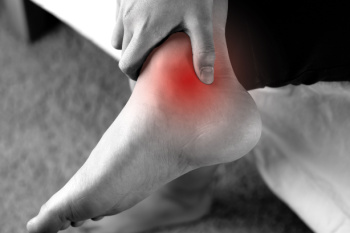Connect With Us
Blog

Young children often run barefoot or in thin shoes, which makes stepping on sharp objects more common than many parents expect. Whether it is a splinter, nail, or shard of glass, puncture wounds to the bottom of the foot can be more serious than they first appear. These injuries may seem small on the surface but can drive debris deep into soft tissue, increasing the risk of infection or damage to deeper structures. Early signs such as swelling, redness, or limping should not be ignored. Proper cleaning is important, but some wounds may require medical attention, especially if the object was dirty or the child is overdue for a tetanus shot. If your child has pain or difficulty walking after a puncture wound, it is suggested that you see a podiatrist as quickly as possible for a complete evaluation and care plan.
Wound care is an important part in dealing with diabetes. If you have diabetes and a foot wound or would like more information about wound care for diabetics, consult with Keleigh Muxlow, DPM from Colorado. Our doctor will assess your condition and provide you with quality foot and ankle treatment.
What Is Wound Care?
Wound care is the practice of taking proper care of a wound. This can range from the smallest to the largest of wounds. While everyone can benefit from proper wound care, it is much more important for diabetics. Diabetics often suffer from poor blood circulation which causes wounds to heal much slower than they would in a non-diabetic.
What Is the Importance of Wound Care?
While it may not seem apparent with small ulcers on the foot, for diabetics, any size ulcer can become infected. Diabetics often also suffer from neuropathy, or nerve loss. This means they might not even feel when they have an ulcer on their foot. If the wound becomes severely infected, amputation may be necessary. Therefore, it is of the upmost importance to properly care for any and all foot wounds.
How to Care for Wounds
The best way to care for foot wounds is to prevent them. For diabetics, this means daily inspections of the feet for any signs of abnormalities or ulcers. It is also recommended to see a podiatrist several times a year for a foot inspection. If you do have an ulcer, run the wound under water to clear dirt from the wound; then apply antibiotic ointment to the wound and cover with a bandage. Bandages should be changed daily and keeping pressure off the wound is smart. It is advised to see a podiatrist, who can keep an eye on it.
If you have any questions, please feel free to contact our office located in Littleton, CO . We offer the newest diagnostic and treatment technologies for all your foot care needs.

Tarsal coalition occurs when two or more bones in the back of the foot are abnormally connected. This connection may be made of bone, cartilage, or fibrous tissue and can limit foot movement, causing pain or stiffness. It often develops during childhood but may not cause symptoms until adolescence or early adulthood. Common signs include frequent ankle sprains, flat feet, and difficulty with physical activity. Treatment depends on the severity of the symptoms. Conservative care includes rest, targeted exercise, orthotics, or immobilization. In more serious cases, surgery may be needed to remove the abnormal connection or to fuse the bones. If you or your child experiences foot pain, stiffness, or unexplained walking difficulty, it is suggested that you see a podiatrist for an accurate diagnosis and appropriate treatment.
Tarsal tunnel syndrome can be very uncomfortable to live with. If you are experiencing tarsal tunnel syndrome, contact Keleigh Muxlow, DPM of Colorado. Our doctor can provide the care you need to keep you pain-free and on your feet.
Tarsal Tunnel Syndrome
Tarsal tunnel syndrome, which can also be called tibial nerve dysfunction, is an uncommon condition of misfiring peripheral nerves in the foot. The tibial nerve is the peripheral nerve in the leg responsible for sensation and movement of the foot and calf muscles. In tarsal tunnel syndrome, the tibial nerve is damaged, causing problems with movement and feeling in the foot of the affected leg.
Common Cause of Tarsal Tunnel Syndrome
- Involves pressure or an injury, direct pressure on the tibial nerve for an extended period of time, sometimes caused by other body structures close by or near the knee.
- Diseases that damage nerves, including diabetes, may cause tarsal tunnel syndrome.
- At times, tarsal tunnel syndrome can appear without an obvious cause in some cases.
The Effects of Tarsal Tunnel Syndrome
- Different sensations, an afflicted person may experience pain, tingling, burning or other unusual sensations in the foot of the affected leg.
- The foot muscles, toes and ankle become weaker, and curling your toes or flexing your foot can become difficult.
- If condition worsens, infections and ulcers may develop on the foot that is experiencing the syndrome.
A physical exam of the leg can help identify the presence of tarsal tunnel syndrome. Medical tests, such as a nerve biopsy, are also used to diagnose the condition. Patients may receive physical therapy and prescriptive medication. In extreme cases, some may require surgery.
If you have any questions please feel free to contact our office located in Littleton, CO . We offer the newest diagnostic and treatment technologies for all your foot and ankle needs.

A bump on the bottom of the foot can be caused by several common conditions, including plantar warts, calluses, or a plantar fibroma. Each has distinct causes and symptoms. Plantar warts are caused by the human papillomavirus or HPV, and often appear as rough, grainy growths with tiny black dots. They may be painful when walking. Plantar calluses are thickened areas of skin that develop from repeated pressure or friction, and are typically painless unless they become very thick. A plantar fibroma is a firm, fibrous lump in the arch of the foot caused by a benign tissue growth in the plantar fascia, which may cause discomfort when walking or standing. A podiatrist can examine the bump and determine the exact cause. Treatments vary and may include cryotherapy, trimming thickened skin, orthotics, targeted exercises, or minor surgery, for fibromas. If you have a painful bump on the bottom of your foot, it is suggested that you schedule an appointment with a podiatrist for appropriate treatment.
Foot Pain
Foot pain can be extremely painful and debilitating. If you have a foot pain, consult with Keleigh Muxlow, DPM from Colorado. Our doctor will assess your condition and provide you with quality foot and ankle treatment.
Causes
Foot pain is a very broad condition that could be caused by one or more ailments. The most common include:
- Bunions
- Hammertoes
- Plantar Fasciitis
- Bone Spurs
- Corns
- Tarsal Tunnel Syndrome
- Ingrown Toenails
- Arthritis (such as Gout, Rheumatoid, and Osteoarthritis)
- Flat Feet
- Injury (from stress fractures, broken toe, foot, ankle, Achilles tendon ruptures, and sprains)
- And more
Diagnosis
To figure out the cause of foot pain, podiatrists utilize several different methods. This can range from simple visual inspections and sensation tests to X-rays and MRI scans. Prior medical history, family medical history, and any recent physical traumatic events will all be taken into consideration for a proper diagnosis.
Treatment
Treatment depends upon the cause of the foot pain. Whether it is resting, staying off the foot, or having surgery; podiatrists have a number of treatment options available for foot pain.
If you have any questions, please feel free to contact our office located in Littleton, CO . We offer the newest diagnostic and treatment technologies for all your foot care needs.

